Louisiana State Police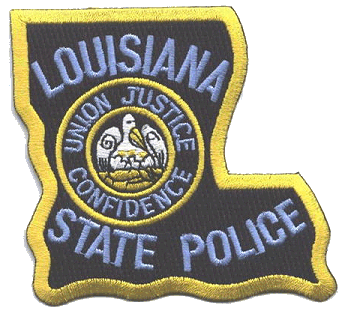
Louisiana State Police
In 1922, the Louisiana Highway Commission was created and given the power to appoint inspectors to enforce laws relating to the highways. The Commission operated with the state divided into ten districts; sixteen officers patrolled the entire state.
During the two year period from 1922 to 1924, 114 serious accidents and 18,918 violations of motor vehicle laws were reported. In 1932 the State Highway Patrol was given the authority to carry firearms. On July 28, 1936, the two divisions of law enforcement were combined to form a modern, well equipped, and well-trained force known as the Louisiana Department of State Police.
In 1942, the Louisiana Legislature abolished the Department of State Police and made it a division of the newly created Department of Public Safety. The LSP accepted new responsibilities in 1946 when the Drivers License Law was enacted requiring every driver to hold a license for operating a motor vehicle. Prior to this time, only the operators of commercial vehicles, trucks, and buses were required to be licensed.
In 1961 the State Legislature passed a new law requiring the inspection of all motor vehicles. Then in 1962, the Legislature enacted a new highway code which established a maximum speed of 65 miles per hour on multilane highways and 60 miles per hour on other highways. Together, these were considered important steps toward improving highway safety.
1972 saw a reorganization of the LSP by adding three regional offices to supervise the eleven troop districts, and in 1984, the LSP had a head count of 960 troopers. Continued budget cuts in 1988 resulted in the closure of Troop H in Leesville and Troop K in Opelousas and the consolidation of the State Police structure into three regional commands with three troops in each region. Also, the Criminal Investigation Bureau was reorganized and reduced in size, severely affecting investigations. The LSP's manpower dipped to 650 troopers patrolling the state's highways.
A long-term goal was achieved on November 22, 2003 when the department received national accreditation by the Commission on Accreditation for Law Enforcement Agencies (CALEA). Currently, the LSP is a force of 1022 men and women responsible for all elements of criminal and highway safety interdiction in the Bayou State.
It is unknown what type of license plates were used on state highway traffic enforcement vehicles prior to the formation of the LSP in 1936.
 1936-1940 issue- First issue. Embossed steel.
1936-1940 issue- First issue. Embossed steel. 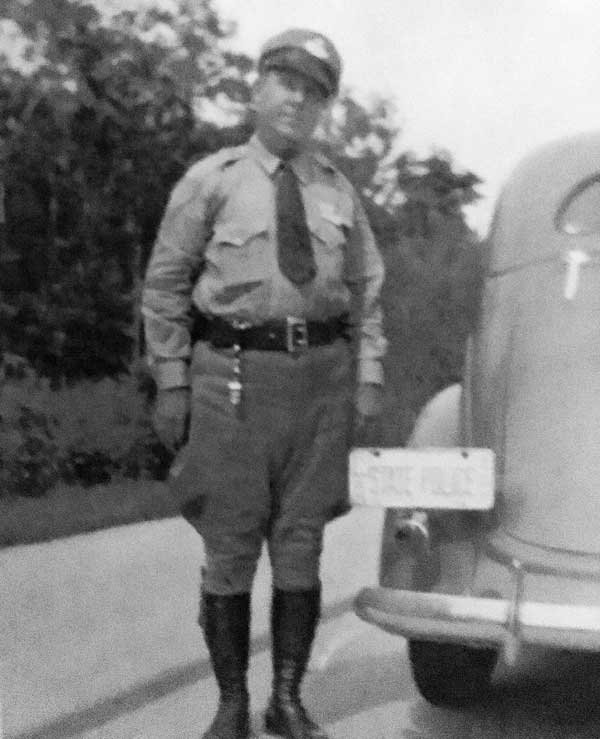 First issue LASP license plate on 1939 car.
First issue LASP license plate on 1939 car.When the Louisiana State Police was created in 1936, special agency-titled license plates were developed and issued to the new fleet of patrol cars and motorcycles. The car plates measured approximately 5 1/2 inches by 13 1/2 inches and were made of embossed steel. The state abbreviation LA was stacked vertically on the left followed by STATE POLICE and the assignment number stacked vertically on the right. Motorcycle plates measured approximately 3 inches by 8 3/4 inches and used the same color combination and format with the exception of STATE POLICE being stacked as two lines instead of one as on the car plates.
All known surviving car-sized LSP license plates of this era are in the 100 series. As the LSP fleet was under 40 cars at that time, it is believed that car numbers began in the 100 series so as to not conflict with the one and two digit numbers of LSP motorcycle plates. There is further speculation that the lead 1 of the number may have indicated a Troop A car and that a number in the 200 series would be Troop B etc... however this is merely another hypothesis.
The difference between the first and second issue LSP license plates is as a result of arguably the most surprising and entertaining lore in state police vehicle licensing history. Louisiana is Cajun Country: settled by displaced French Acadian settlers many generations earlier. It makes the cajun creole french language and dialect a very distinctive and exclusive trait for the Bayou State alone. As can be seen on the first issue plate, the state's abbreviation LA prefaces everything else. Well, some observant and witty travelers to Louisiana back in the day took note of these distinctive license plates gracing the front and rear end of LSP's patrol vehicles and began to note that they had just seen "La state police" ! The joke caught on and the Louisiana State Police were getting to be known more and more as "la state police".
In 1940, the LSP had a new man in charge, and one of the first items on his agenda was to put a stop to the ridicule of his fine agency. All the "LA State Police" plates were recalled and allegedly ordered destroyed and replaced with a brand new plate to be run front and rear of all LSP cars. The new plate was the same size and color as the previous plate, however the state name LOUISIANA was emblazoned in full along the top of the plate, and to add the right amount emphasis, an arrow motif pointing inward at the state name from both sides was added! The "La State Police" jokes thus ended...immediately!
 1940-Circa 1942 issue- Second issue. Embossed steel. Approx. 5.5"x13.5" This "double arrow" plate was the new LSP Superintendent's effort to stop all the ridicule and jokes made at the LSP's expense due to the previous issue plate. The state abbrevition on the earlier plate in French Cajun country caused the joking phrase "La state police" which struck the ire of the second superintendent.
1940-Circa 1942 issue- Second issue. Embossed steel. Approx. 5.5"x13.5" This "double arrow" plate was the new LSP Superintendent's effort to stop all the ridicule and jokes made at the LSP's expense due to the previous issue plate. The state abbrevition on the earlier plate in French Cajun country caused the joking phrase "La state police" which struck the ire of the second superintendent. 

Around 1942, the LSP introduced a completely different license plate for their patrol cars. There are no surviving specimens known and only the accompanying photo shows proof of its existence. The plate appears to be embossed steel. The dimensions are guessed at around six inches by approximately 13 inches. White characters and border are painted over a darker, possibly red backgound. The state name LOUISIANA is spelled out in full at the top center. The second line reads DEPT OF PUBLIC SAFETY over DIV OF over STATE POLICE over TROOP_A. The number 40 is stacked vertically along the right margin of the plate. It is unknown how long these plates were used, however it is a safe guess that it was until prior to 1949 as a period photo shows a different type of plate gracing the front of a 1949 LSP Ford.



As per the photo below featuring Sgt. Abel P. Prejean (left) and Tpr. Elmo J. Falgout Sr. standing in front of a 1949 LSP Ford, the LSP issued a fourth license plate design around that time. Up until the discovery of this photo, it was believed that the previous issue from 1942 had been used on LSP cars until 1958. The plate seen in this photo appears to be embossed steel and possibly measuring approximately 6 inches by 12 1/2 inches. It is believed to have been red over white with the state name LOUISIANA along the top center. As the photo was taken along US Route 90 in Raceland in 1949 or 1950, it is likely to have had Troop letter C prefix, however, Sgt Prejean's left leg is in the way to confirm! This would have been followed with STATE over POLICE followed by the assignment number using small motorcycle numeral dies. In this case, the number 8. It is likely that this type was used until the "Chinese red" plate that came out around 1954.
A larger version of this photo can be seen in the Gallery at the botom of the page.



Around 1954, the Louisiana State Police issued a new license plate for its marked patrol cars and it was believed to have been run on the rear of the car only as with all subsequent LSP plates. The plate was embossed steel and measured approximately 5 1/4 inches by 11 3/4 inches. The colors were white over Chinese red. The state name LOUISIANA in small lettered font was centered at the top. A large Troop letter was situated at the far left of the plate followed by STATE over POLICE and a number stacked vertically was situated on the right side using small motorcycle numeral dies. The map below shows current Troop locations for the LSP.
The LSP Troop assignments during the 1950's to 1970's were as follows:
Troop A (Baton Rouge) Troop B (New Orleans) Troop C (Franklin) Troop D (Lake Charles) Troop E (Alexandria) Troop F (Monroe) Troop G (Shreveport) Troop H (Leesville) Troop I (Lafayette) K (Opelousas) Troop L (Covington) Troop M (Des Allemands) Troop N (Crowley) Troop O (Delhi)
Sometime in the early 1970's the LSP went from 14 Troops down to eleven. By 1975, the LSP Troop allocations were as follows:
Troop A (Baton Rouge) Troop B (New Orleans) Troop C (Franklin) Troop D (Lake Charles) Troop E (Alexandria) Troop F (Monroe) Troop G (Shreveport) Troop H (Leesville) Troop I (Lafayette) Troop K (Opelousas) Troop L (Covington) Troop N (New Orleans-French Quarter added in 2016) HQ (Headquarters)
Today as seen by the map below, the LSP Troop assignments are as follows:
Troop A (Baton Rouge) Troop B (Kenner) Troop C (Gray) Troop D (Lake Charles) Troop E (Alexandria) Troop F (Monroe) Troop G (Bossier City) Troop I (Lafayette) Troop L (Mandeville) HQ (Headquarters)
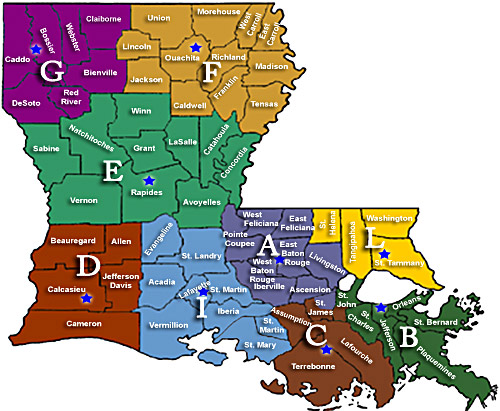
 Circa 1954-1956 issue. Embossed steel. Approx.5 1/4" x 11 3/4". White over Chinese red.
Circa 1954-1956 issue. Embossed steel. Approx.5 1/4" x 11 3/4". White over Chinese red. 


 1956- Circa 1970 issue. Embossed steel. Standard 6" x 12". Reflective white over Chinese red.
1956- Circa 1970 issue. Embossed steel. Standard 6" x 12". Reflective white over Chinese red. 

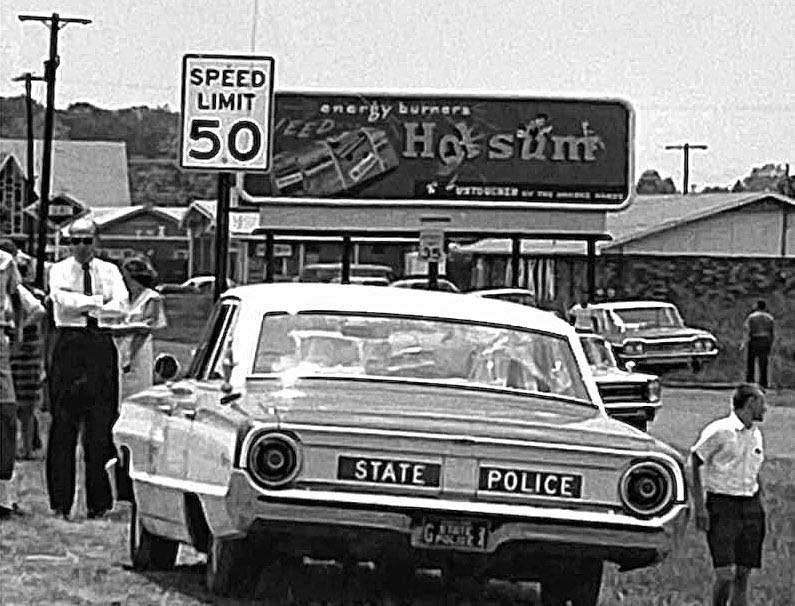 1964 Troop G (Shreveport)
1964 Troop G (Shreveport) Troop B (New Orleans) Car 16 Circa 1967
Troop B (New Orleans) Car 16 Circa 1967There is no concrete information as to when particular versions of LSP license plates were issued even well-into the 1960's and 1970's when record keeping became a bit more stringent than in years prior. The timeframes used for this archive is based solely on period photographs and the personal recollection of LSP retirees.
The switch-over from red plates to reflective white plates is believed to have taken place around 1969 to 1970. It was also during this time that the state of Louisiana began to switch materials fro maunfacturing license plates. Therefore some of the 1970's era plates are made of galvanized steel and some are made of aluminum. It should be noted that some plates bore the state name in larger, wider font and others in smaller and more narrow font which is shown further below. It is unclear if those changes were based on the years they were issued or based on random die changes in the punch press at Angola Prison that churned these plates out over those years.
What is known is that the numbering system for each troop followed the same pattern:
Troop Letter followed by number 1 (Troop Commander- Captain)
Troop letter followed by number 2 (Administrative Lieutenant)
Troop letter followed by number 3 to 8 (Lieutenant)
Troop letter followed by number 9 to 18 (Sergeant)
Troop letter followed by number 19 onward (Corporals and Troopers)

 1956-Circa 1970 issue. Reflective white over Chinese red. Version with larger/wider font for LOUISIANA.
1956-Circa 1970 issue. Reflective white over Chinese red. Version with larger/wider font for LOUISIANA. 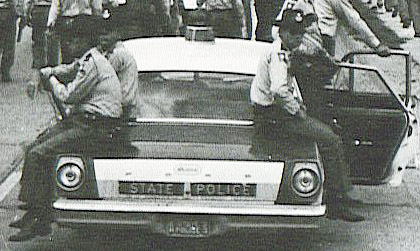 Troop A (Baton Rouge)
Troop A (Baton Rouge)
 Circa 1970-1978 issue. Embossed aluminum. Red over reflective white.
Circa 1970-1978 issue. Embossed aluminum. Red over reflective white.  Troop L (Covington)
Troop L (Covington) Circa 1970-1978 issue. Embossed aluminum. Version with larger/wider font for LOUISIANA. Troop M (Des Allemands) Car 29.
Circa 1970-1978 issue. Embossed aluminum. Version with larger/wider font for LOUISIANA. Troop M (Des Allemands) Car 29.  Troop B (New Orleans)
Troop B (New Orleans)
 Circa 1970-1978 issue. Brighter reflective white background and using smaller/narrower font for LOUISIANA.
Circa 1970-1978 issue. Brighter reflective white background and using smaller/narrower font for LOUISIANA. 
 Difference in die font for state name on top of plates
Difference in die font for state name on top of plates Difference in die font for state name on bottom of plates
Difference in die font for state name on bottom of plates Circa 1978-1989 issue. Version with no dash to separate the Troop letter from the assignment number and using smaller/narrower dies for LOUISIANA.
Circa 1978-1989 issue. Version with no dash to separate the Troop letter from the assignment number and using smaller/narrower dies for LOUISIANA.

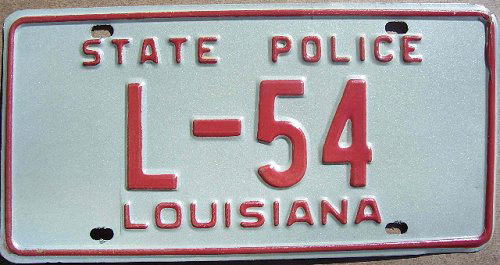 Circa 1978-1989 issue. Version with dash to separate the Troop letter from the assignment number and using longer/wider dies for LOUISIANA.
Circa 1978-1989 issue. Version with dash to separate the Troop letter from the assignment number and using longer/wider dies for LOUISIANA. 
 Circa 1978-1989 issue. Version with dash to separate the Troop letter from the assignment number and using longer/wider dies for LOUISIANA.
Circa 1978-1989 issue. Version with dash to separate the Troop letter from the assignment number and using longer/wider dies for LOUISIANA. 
 Circa 1978-1989 issue. R prefix is believed to be for REPLACEMENT when an assigned LSP license plate is either stolen or lost. No confirmation as of this writing.
Circa 1978-1989 issue. R prefix is believed to be for REPLACEMENT when an assigned LSP license plate is either stolen or lost. No confirmation as of this writing.

In 1989, the state of Louisiana commenced "re-plating" all motor vehicles in the Bayou State. License plates used by the LSP were part of that change. The new plates had dark blue raised characters and borders over a reflective white background. The state emblem of a mother pelican wounding her own breast to feed her three offspring is depicted in silkscreen in each top corner of the plate. The mother pelican's head is turned to face the center from each side. The state name is stylized in silkscreened red and blue where the USA inside the word LOUISIANA is in larger blue font while the rest of the state name is in smaller red font. The center of the plate is where the embossed characters (Troop letter and assignment number) is placed. The title STATE POLICE is silkscreened in red between the lower mounting holes. This plate is better known as the "USA base".
Many versions of this plate have silkscreened holograms running down the center of the sheeting on the plate which bear the state shape and the last two digits of the year the plate was made ie: 89 for 1989.
It was around this time when the LSP experimented with changing the color of the fleet from white vehicles with red livery to dark blue with gold livery.

 1989-1993 issue. USA base. Version using dash to separate Troop letter from assignment number.
1989-1993 issue. USA base. Version using dash to separate Troop letter from assignment number. 
 1989-1993 issue. USA base. Version using no dash to separate Troop letter from assignment number.
1989-1993 issue. USA base. Version using no dash to separate Troop letter from assignment number.
 1989-1993 issue. USA base. Version using no dash.
1989-1993 issue. USA base. Version using no dash.  Troop F (Monroe)
Troop F (Monroe)
 1989-1993 issue. USA base. Version using dash to separate Troop letter from assignment number.
1989-1993 issue. USA base. Version using dash to separate Troop letter from assignment number. 

 1989-1993 issue. USA base. Department of Public Safety prefix. DPS/Capitol Police, is responsible for security in and around all state facilities located outside of the Capitol Complex. This includes facilities located in New Orleans, Lafayette, Alexandria, Shreveport, and Monroe.
1989-1993 issue. USA base. Department of Public Safety prefix. DPS/Capitol Police, is responsible for security in and around all state facilities located outside of the Capitol Complex. This includes facilities located in New Orleans, Lafayette, Alexandria, Shreveport, and Monroe. 
In late 1993, Louisiana replated again and the LSP followed suit as well. This time the plates were once again using dark blue embossed characters and borders over a reflective white background. The state name was silkscreened in red at the top in a stylized long hand script known as "lipstick". The center of the plate was occupied with the Troop letter and assignment number and the bottom of the plate had the word STATE POLICE embossed along the bottom just above the lower mounting holes. There was also a distinctive silkscreened red rectangle occupying the lower right corner for reasons unknown. This plate is better known as the "Lipstick base".
It was also around this time when the LSP returned to the white vehicles with red livery.


 1994-Current issue. Lipstick base.
1994-Current issue. Lipstick base. 

 1994-Current issue. Lipstick base. TS is stated to be Technical Service (reconstructionist) but it has also been said to be Traffic Services for use by Commercial Vehicle Enforcement. Need confirmation.
1994-Current issue. Lipstick base. TS is stated to be Technical Service (reconstructionist) but it has also been said to be Traffic Services for use by Commercial Vehicle Enforcement. Need confirmation.
 1994-Current issue. Lipstick base. Hazardous Material Specialist.
1994-Current issue. Lipstick base. Hazardous Material Specialist.
 1994-Current issue. Lipstick base.
1994-Current issue. Lipstick base. 
 1994-Current issue. Lipstick base.
1994-Current issue. Lipstick base. 
 1994-Current issue. Lipstick base. Version with dash separating the Troop letter from the assignment number.
1994-Current issue. Lipstick base. Version with dash separating the Troop letter from the assignment number. 
 1994-Current issue. Lipstick base. Motor Pool. Version with dash separating the Troop letter from the assignment number. This version used on a marked State Police car using PUBLIC SAFETY title.
1994-Current issue. Lipstick base. Motor Pool. Version with dash separating the Troop letter from the assignment number. This version used on a marked State Police car using PUBLIC SAFETY title.
 1994-Current issue. Lipstick base.
1994-Current issue. Lipstick base.
 1994-Current issue. Lipstick base.
1994-Current issue. Lipstick base. 
 1994-Current issue. Lipstick base. MOTORS used by LSP troopers who also ride patrol on motorcycle.
1994-Current issue. Lipstick base. MOTORS used by LSP troopers who also ride patrol on motorcycle. 
 1994-Current issue. Lipstick base.
1994-Current issue. Lipstick base.
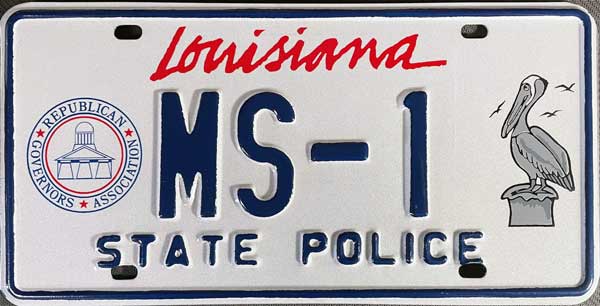 Republican Governors Association.
Republican Governors Association.
 2016-Current. Lipstick base.
2016-Current. Lipstick base. (Courtesy Bill Ceravola)
(Courtesy Bill Ceravola)  1994-Current issue. Lipstick base. Version with dash separating the Troop letter from the assignment number.
1994-Current issue. Lipstick base. Version with dash separating the Troop letter from the assignment number. 
 1994-Current. Titled TROOPER optional front plate. This is the DMV-issued version on standard embossed aluminum with a reflective background and short oval mounting holes.
1994-Current. Titled TROOPER optional front plate. This is the DMV-issued version on standard embossed aluminum with a reflective background and short oval mounting holes. DMV made optional TROOPER front plate
DMV made optional TROOPER front plate Titled TROOPER optional front plate. This is the "souvenir version" as seen on the LSP camaro shown below which is embossed thin aluminum on a non-reflective background. These were also issued as a souvenir the year the National Trooper Coalition conference was hosted by LSP.
Titled TROOPER optional front plate. This is the "souvenir version" as seen on the LSP camaro shown below which is embossed thin aluminum on a non-reflective background. These were also issued as a souvenir the year the National Trooper Coalition conference was hosted by LSP.

 1994-Current issue. Lipstick base. All silkscreened with exception of border. Displayed front only.
1994-Current issue. Lipstick base. All silkscreened with exception of border. Displayed front only.
 1994-Current issue.
1994-Current issue. 
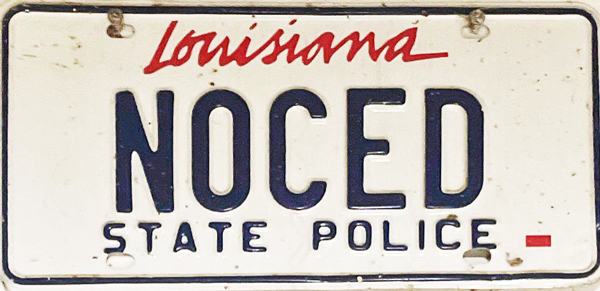 1994-Current issue New Orleans Criminal Enforcement Detail.
1994-Current issue New Orleans Criminal Enforcement Detail. 
 1994-2011 issue. Lipstick base. Prototype for Criminal Patrol Unit which features graphic of LSP badge in dark blue and embossed pelican which had been a standard feature on Louisiana license plates in the 1950's and 1960's. This type was issued more as a novelty and not officially displayed on LSP vehicles.
1994-2011 issue. Lipstick base. Prototype for Criminal Patrol Unit which features graphic of LSP badge in dark blue and embossed pelican which had been a standard feature on Louisiana license plates in the 1950's and 1960's. This type was issued more as a novelty and not officially displayed on LSP vehicles.
 1994-Current issue. Criminal Patrol Unit. Lipstick base. Displayed front only.
1994-Current issue. Criminal Patrol Unit. Lipstick base. Displayed front only.
 1994-Current issue. Criminal Patrol. Lipstick base. Spelled-out in silkscreen. Unsure if this was issued before or after CPU.
1994-Current issue. Criminal Patrol. Lipstick base. Spelled-out in silkscreen. Unsure if this was issued before or after CPU. 
 1994-Currrent issue.
1994-Currrent issue.  (Courtesy Bill Ceravola)
(Courtesy Bill Ceravola) 1994-Current issue.
1994-Current issue. 
 End Of Watch Memorial plate.
End Of Watch Memorial plate.

For the Louisiana State Police's 75th Anniversary in 2011, arrangements were made between the LSP and the Louisiana Department of Motor Vehicles to manufacture attractive graphic license plates to commemorate the Diamond Anniversary of the agency.
The plates once again had dark blue embossed characters and border over a reflective white background. The rest of the plate is silkscreened graphic. The state name appears in red between the upper mounting holes with the inscription 1936 75th Anniversary 2011 beneath it in dark blue. The title STATE POLICE is situated between the lower mounting holes in red. The left side of the plate is occupied by an attractive graphic of a dark blue fleur de lys trimmed in gold. The words Louisiana State Police occupy the center, left and right petals in white. The center petal also features the state emblem of "The Pelican in her Piety". The center of the emblem features a circular diagram with 75 inside. The base of the emblem reads 1936-2011 in white. This emblem is superimposed over a silhouette of the state in gold. The design also features a faded gold laurel that traverses from the top left corner of the plate down to the area just right of the lower left mounting hole. A helixed security feature hologram runs down the center of the plate embedded in the reflective sheeting.
These plates were run only for the duration of the anniversary. LSP members were permitted to purchase and retain their plates as keepsakes, but were "administratively compelled" not to relinquish these plates to a third party.
The LSP then returned to running the "Lipstick base" plates from 2012 onward.
 2011 issue. Commemorating the 75th Anniversary of the LSP. Run only during course of the anniversary year.
2011 issue. Commemorating the 75th Anniversary of the LSP. Run only during course of the anniversary year.  Troop L (Mandeville) Car 3
Troop L (Mandeville) Car 3 2011 issue. Commemorating the 75th Anniversary of the LSP. Run only during course of the anniversary year. Headquarters car.
2011 issue. Commemorating the 75th Anniversary of the LSP. Run only during course of the anniversary year. Headquarters car.
A small number of state police/highway patrol agencies in the United States have a Motor Vehicle Larceny Enforcement Program called ACE. ACE is an acronym for "Aggressive Criminal Enforcement". Started by the Ohio State Highway Patrol in 1972, the Louisiana State Police is believed to have followed suit with a similar program shortly thereafter, as nobody so far can recall the exact date or year that the program started with LSP.
The program was initiated in response to the increasing amount of car theft that was taking place since the 1960's. The program was also introduced to act as an incentive for troopers on the road to seek-out stolen motor vehicles and apprehend the thieves beyond the sense of a job well-done.
In Louisiana's case, each recovered stolen vehicle and arrest of the thief earned the Trooper an oval decal depicting a red lightning bolt. This decal was permitted to be affixed to the left front fender of the Trooper's patrol car in the same vein as what World War 2 fighter-pilots did by affixing emblems to their aircraft's fuselage depicting enemy aircraft shot-down during their missions.
Once the Trooper attained five stolen auto recoveries/arrests, an ACE decal and license plate was earned. The ACE decal was a larger oval with a dark blue silhouette of the state and a large red lightning bolt running diagonally from the upper left to the lower right of the decal.
The ACE license plate was identical to the regular LSP license plate with the exception of the letters ACE occupying the center of the plate. The plates were run on the front of the car only, and solely for the year in which the award was earned. If the Trooper maintained a five stolen vehicle recovery/arrest rate, they were permitted to retain their ACE status and plate into the next year.
At the end of the year, the LSP Trooper with the highest rate of auto theft recovery/arrest in the state, was bestowed the BLUE MAX award. This is otherwise known as the "Ace of ACEs". The minimum criteria to become a BLUE MAX recipient is twenty-five stolen vehicle recoveries/arrests within the year. The BLUE MAX recipient is stated to also earn a service medal and certificate of recognition. The BLUE MAX plate was made highly-distinctive by being painted gold over dark blue: the uniform colors of the LSP. The layout/format was the same as regular LSP license plates of the time, however BLUE MAX occupied the center of the plate and was silkscreened. The later versions of the BLUE MAX plates used embossed characters for the title.
Needless to say, these hard-earned plates are very difficult to obtain for collectors, not only due to there being so few made and presented, but the recipients usually hang-on to them long-into retirement as keepsakes of their hard work. They usually don't become available to collectors until the BLUE MAX recipient passes-away.
 Early prototype. Flat screened metal. This is a confirmed LSP plate and not a fake mock-up.
Early prototype. Flat screened metal. This is a confirmed LSP plate and not a fake mock-up.
 1970's- Early 1980's issue.
1970's- Early 1980's issue.  1978 LSP Ford. Decals indicate 7 stolen vehicle recoveries/arrests.
1978 LSP Ford. Decals indicate 7 stolen vehicle recoveries/arrests.
 1970's-Early 1980's issue. Version with larger/wider font for LOUISIANA.
1970's-Early 1980's issue. Version with larger/wider font for LOUISIANA. It happens to the best...
It happens to the best... 1987- Phil Stanford- 27 ACEs
1987- Phil Stanford- 27 ACEs

 1989-1993 issue. USA base.
1989-1993 issue. USA base.
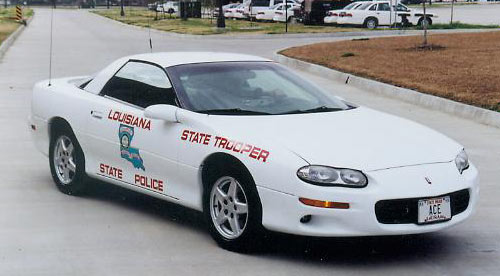


On Wednesday, March 8, 2017, DPS Officer Helen DeLatte became the first Louisiana Department of Public Safety (DPS) Officer to receive the Louisiana State Police ACE Award. The ACE Award is reserved for those who demonstrate heightened proficiency and effort during the performance of their duties by recovering five stolen vehicles (each with the apprehension of a suspect) within a 12 month period. Officer DeLatte met the above criteria while in the performance of her duties between October, 2015 and September, 2016.
The ACE (Aggressive Criminal Enforcement) Award has in the past only been awarded to Louisiana State Police Troopers. An “ACE” decal, consisting of a blue State of Louisiana with a red lightning bolt, is affixed to the patrol vehicle of each Trooper who earns the award. However, since DPS Officer DeLatte has now become the first within her agency to receive the award, a new decal consisting of a grey State of Louisiana with a blue lightning bolt has been created. These decals will be affixed to the patrol cars of any future DPS officers who earns the award.
“I am extremely proud of the work that our DPS Officers perform across our state daily,” stated Colonel Mike Edmonson, State Police Superintendent. “Throughout our department’s history, the ACE Award has been highly sought after by Troopers. Now we are excited that DPS Officers can share in this proud tradition as well.”
Officer DeLatte has been serving the citizens of Louisiana as an officer assigned to the Crescent City Connection since 2006.
(Courtesy Bill Ceravola).

 Current issue LSP ACE plate.
Current issue LSP ACE plate.

 September 22 1982. Phillip A. Stanford wins the Blue Max Award.
September 22 1982. Phillip A. Stanford wins the Blue Max Award. 1970's-Early 1980's issue.
1970's-Early 1980's issue.  1970's-Early 1980's issue.
1970's-Early 1980's issue.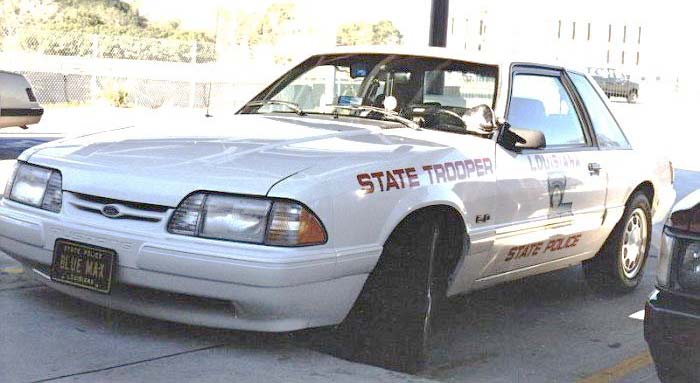
 1994-Current issue. Embossed and silkscreened aluminum.
1994-Current issue. Embossed and silkscreened aluminum.
 Blue Max Award 2017 - Awarded for the most recovered stolen vehicles with arrests in a 12 month period:
Blue Max Award 2017 - Awarded for the most recovered stolen vehicles with arrests in a 12 month period:In 1986, the Louisiana State Police celebrated its Golden Anniversary. Although no special license plates were issued for the milestone, the LSP commissioned license plate-sized reflective decals that were affixed to the left front fender of marked LSP vehicles for the duration of the anniversary year.
The decal was reflective white. The center of the decal was occupied by a large outline of the state in black. The left side of the decal was occupied by the words 50 YEARS and the right side of the decal was occupied by the words OF PRIDE in black stylized font.
The center of the state outline featured the "pelican in her piety" emblem over a blue and gold square motif. Below this is a sprig of wildflower design atop a scroll in gold saying LOUISIANA STATE POLICE in black. Below that, SINCE 1936 in black at the bottom.
 Golden Anniversary fender decal issued for 1986.
Golden Anniversary fender decal issued for 1986.  (Courtesy Dwayne Larriviere)
(Courtesy Dwayne Larriviere)The Louisiana State Police has used motorcycles consistenly in their fleet since their inception. The earliest riders of the LSP were known as "Motor cycle boys".
The license plates used in the earliest days of the agency were embossed steel and measured approximately 3 inches by 8 3/4 inches. They were painted red over off-white similar to the car-sized plates of the day and had only two mounting holes at the top of the plate. The state prefix LA was stacked on the left followed by STATE over POLICE followed by a number up to two digits stacked on the right.
These plates were used from 1936 right through the late 1940's and possibly into the early 1950's. These plates are stated to have been re-used when motorcycles were changed-out.
In the 1950's, a white over Chinese red plate was issued as with the LSP cars of the time. The motorcycle plates were embossed steel and measured approximately 3 inches by 9 inches with four mounting holes. A large Troop letter occupied the left end of the plate. The state name LOUISIANA was situated just below the upper mounting holes over the title STATE POLICE in slightly larger font below it. The assignment number was stacked to the right. These plates were used right through the LSP plate changeover around 1970.
The LSP continued to issue motorcycle license plates along the same format as their car-sized plates right up until current times and are shown below.
 1930's Louisiana State Police Motorcycles
1930's Louisiana State Police Motorcycles 1936-Late 1940's issue. Embossed steel. Approx. 3" x 8 3/4".
1936-Late 1940's issue. Embossed steel. Approx. 3" x 8 3/4".


 Possibly early 1950's motorcycle issue.
Possibly early 1950's motorcycle issue.
 1950's-Circa 1970 issue.
1950's-Circa 1970 issue. 
 1950's-circa 1970 issue.
1950's-circa 1970 issue. 
 Louisiana SP pre-1970 motorcycle license plates.
Louisiana SP pre-1970 motorcycle license plates. Circa 1970 issue. Embossed steel. Approx. 3" x 9".
Circa 1970 issue. Embossed steel. Approx. 3" x 9".

 Circa 1970-1989. Embossed aluminum. Approx. 4" x 9".
Circa 1970-1989. Embossed aluminum. Approx. 4" x 9". 
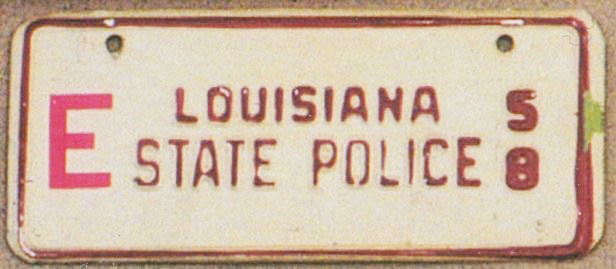 Circa 1970-1989. Embossed aluminum. Approx. 4" x 9".
Circa 1970-1989. Embossed aluminum. Approx. 4" x 9". 
 Circa 1975-1989. Embossed aluminum.
Circa 1975-1989. Embossed aluminum.
 1989-1993 issue. USA base.
1989-1993 issue. USA base. 
 1994 issue. Lipstick base.
1994 issue. Lipstick base. 
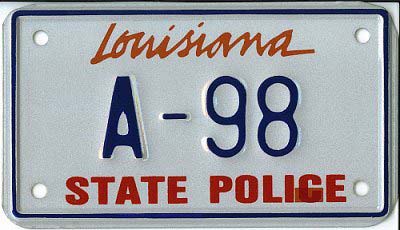 1994-2010 issue. Approx. 4" x 7". Lipstick base with short thick font for STATE POLICE. Dash separates Troop letter from assignment number.
1994-2010 issue. Approx. 4" x 7". Lipstick base with short thick font for STATE POLICE. Dash separates Troop letter from assignment number.

 2010-current issue. Approx. 4" x 7". Lipstick base with larger stylized font for STATE POLICE.
2010-current issue. Approx. 4" x 7". Lipstick base with larger stylized font for STATE POLICE. 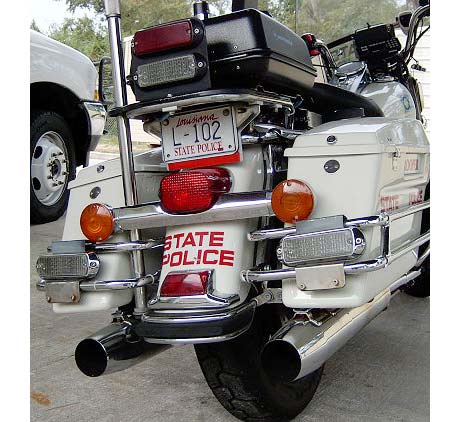
 Beautiful LSP Motorcycle License Plate Display of Bill Cervola.
Beautiful LSP Motorcycle License Plate Display of Bill Cervola. Dash plates. Approx. 4" x 9". For use by unmarked LSP units.
Dash plates. Approx. 4" x 9". For use by unmarked LSP units. Circa 1990 dash plate. Approx. 4"x 9".
Circa 1990 dash plate. Approx. 4"x 9".  Circa 2000 dash plate. Approx. 4"x 9".
Circa 2000 dash plate. Approx. 4"x 9". 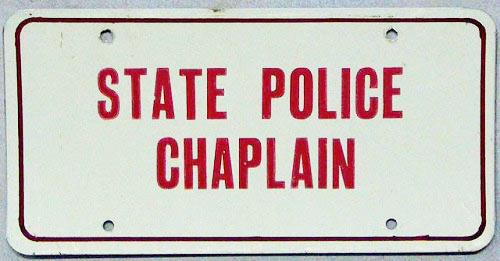 Unconfirmed use by LSP. State Police Chaplain dash plate.
Unconfirmed use by LSP. State Police Chaplain dash plate. 2017 dash plate. Full size.
2017 dash plate. Full size.The Louisiana Highway Safety Commission (LHSC) administers the State's highway safety grant program. The LHSC works closely with the Louisiana State Police with respect to proactive highway safety initiatives. Louisiana's highway safety program is designed to reduce traffic crashes and the resulting deaths, injuries and property damage. Programs and projects are administered in accordance with uniform guidelines promulgated by the NHTSA and FHWA.
Projects implemented by the LHSC are limited to priority program areas, based on severity of the crash, over-representation, and magnitude of the problem. There are three contributing factors associated with a traffic crash: the roadway and environment, the vehicle, and the driver.
Driver factors (driving after drinking, speeding, not using occupant protection devices, etc.) contribute to some of the most severe traffic crashes. LHSC's highway safety plan seeks to coordinate and unite state and local programs and projects to reduce traffic crashes, deaths, and injuries by focusing on enforcement, public information and education, and legislation.
The Louisiana Office of Motor Vehicles (OMV) also works closely with the Louisiana State Police and performs functiones related to the examination and licensing of motor vehicle operators. The OMV also deals with the issuance of vehilce title and registration certificates and license plates in the state.
 1989-1993 issue. USA base. This type still being used in 2010.
1989-1993 issue. USA base. This type still being used in 2010. Commissioner of the Louisiana Highway Saefty Commission.
Commissioner of the Louisiana Highway Saefty Commission. 1994-2010 issue for Office of Motor Vehicles-
1994-2010 issue for Office of Motor Vehicles- 
 2010-current issue.
2010-current issue. 
 Old painted steel Louisiana Troopers Association booster plate (Circa 1968-1970's).
Old painted steel Louisiana Troopers Association booster plate (Circa 1968-1970's).